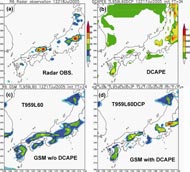Revised Convective Triggering Mechanism Improves Precipitation Forecast
Published: 16 June 2008

An improved convective triggering mechanism developed by ARM scientists based on ARM observations was implemented recently in the Global Spectral Model at the Japan Meteorological Agency (JMA) to improve
surface precipitation forecasts. The revised triggering mechanism uses a dynamic convective available potential energy generation rate (DCAPE) to control the onset of deep convection. It assumes that deep convection occurs only when the large-scale dynamic forcing makes a positive contribution to the existing positive CAPE, i.e., DCAPE >0. This simple dynamic constraint emulates the collective effects of lower-level moistening and upward motion of the large-scale circulation.
With the new triggering mechanism, the revised JMA’s Global Spectral Model with T959 truncation and 60 vertical levels (T959L60DCP) substantially reduced the precipitation bias in the original Global
Spectral Model (T959L60).
For more information, read the research highlight.
The ARM Climate Research Facility is a DOE Office of Science user facility. The ARM Facility is operated by nine DOE national laboratories, including .
Keep up with the Atmospheric Observer
Updates on ARM news, events, and opportunities delivered to your inbox
ARM User Profile
ARM welcomes users from all institutions and nations. A free ARM user account is needed to access ARM data.


















